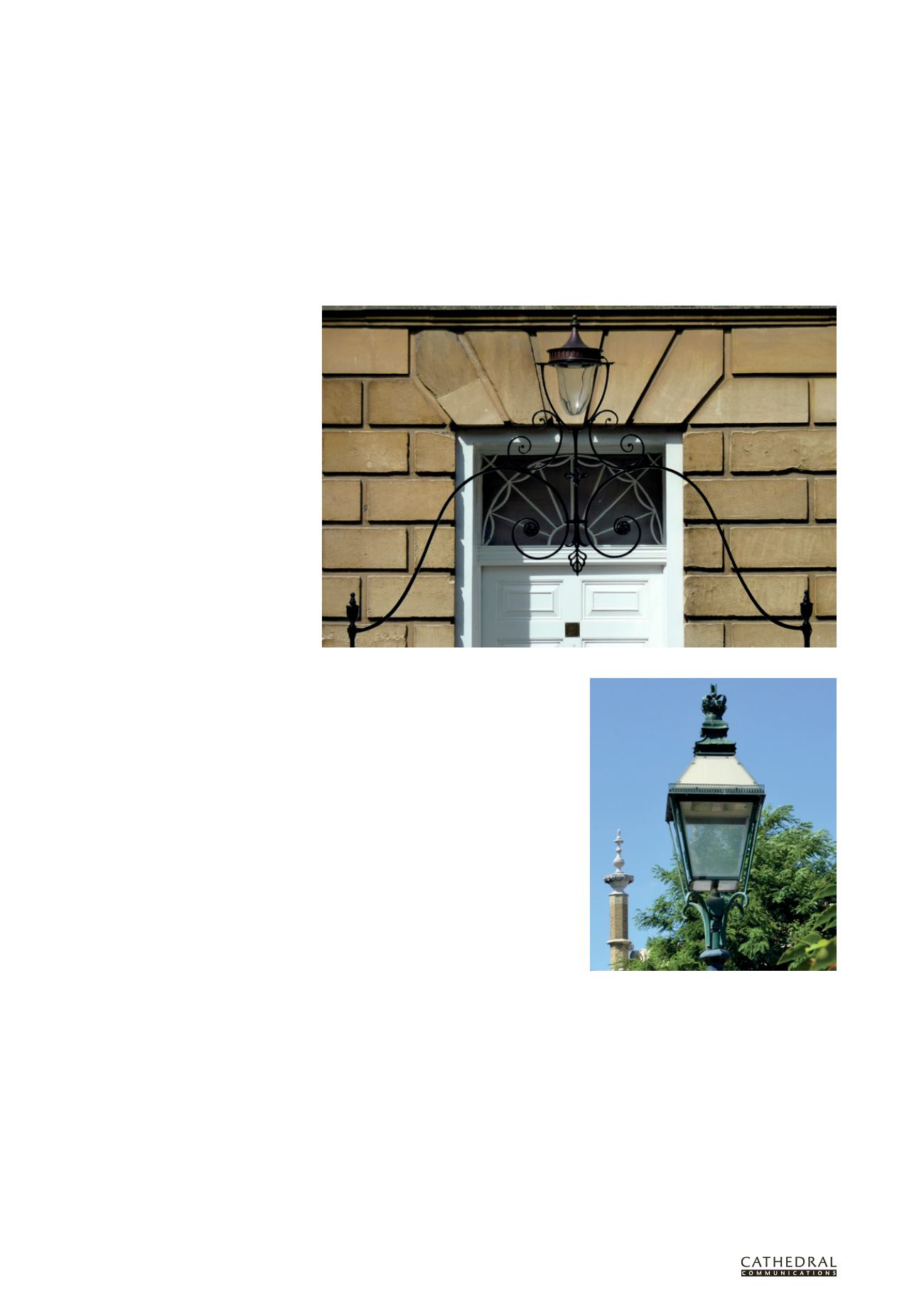

1 3 4
T H E B U I L D I N G C O N S E R VAT I O N D I R E C T O R Y 2 0 1 5
T W E N T Y S E C O N D E D I T I O N
3.4
STRUCTURE & FABR I C :
EXTERNAL WORKS
GEORGIAN andVICTORIAN
STREET LIGHTING
JONATHAN TAYLOR
P
RIOR TO
the Georgian period the
streets of British towns and cities were
largely unlit. Some light filtered from
windows, but inside the homes candles and
oil lamps tended to be used only where light
was necessary. Outside, those that could
afford them carried lanterns or ‘links’, flaming
torches. The first statutory requirements for
lighting streets did not occur until the late
17th century when, in the reign of William
and Mary, eligible householders in the City of
London were required to hang a lantern outside
their homes or pay a rate towards municipal
lighting. Streets were to be lit from the end of
September (Michaelmas) to the end of March
(Lady Day), from dusk to midnight. Many other
towns and cities followed suit during the early
18th century. Bath, for example, introduced
a similar requirement by Act of Parliament
in 1707, and in 1739 a fresh act introduced a
night watch and penalties for extinguishing or
damaging the lights. Led by London, successive
legislative measures defined responsibilities for
municipal lighting as the century progressed.
Street lighting was seen as an essential measure
for deterring crime.
These early street lights usually consisted
of a simple oil lamp suspended from the rim
of a glass bowl and covered by a ventilated
metal cowl. Surviving examples can still be
seen in many parts of Britain where they
form part of the elaborate ironwork in front
of fine Georgian townhouses. The oil lamps
effectively illuminated the pavements but not
the roadways as the small flame and the lack
of a reflector resulted in very limited spread of
light. Furthermore, lighting was concentrated
around shops and in fashionable streets where
there were the most rate-payers. Poorer areas
and streets with few houses remained sparsely
lit, if at all. Refuelling the lamps, trimming
and replacing the wicks and lighting them was
time-consuming and expensive.
Minor improvements in lighting occurred
with successive developments in the design of
oil lamps in the late 18th century, including
some with convex reflectors to cast more
light downwards. The Argand oil lamp was
the most significant of these, becoming the
lighting of choice for the homes of the wealthy
at the end of the century, but it was expensive,
little used for street lighting. Here the major
breakthroughs were the introduction of gas
lighting at the start of the 19th century, the
development of the gas mantle late in the
century, and the introduction of electric arc
lighting at its end.
The first exterior gas lighting was in
Birmingham in 1802. The larger flame
produced far more light than oil lamps and
was almost maintenance-free. In London an
experimental scheme to light Pall Mall was
completed in 1807. By 1814 the City of London
Gas-Light and Coke Company was supplying
coal gas for lighting streets and houses, and by
the 1820s larger towns across Britain had their
own operations. In Bristol the main streets
were lit by gas by 1818, and by 1850 there were
nearly 2,000 street lamps, mostly supported on
tall cast iron posts set into the edge of the kerb
where they illuminated both the roadway and
the footpath.
The development of urban gas works
coincided with the expansion of the railway
network in the 1840s and ’50s which enabled
the proliferation of cast iron lamp posts.
The material provided the ideal medium for
the Victorians, combining new technology
with cheap, mass-produced ornament. An
early example survives in the churchyard of
St Mary’s, Chesterfield. Dating from 1824, its
post is an elegant fluted column with a slightly
bulbous base clasped by leaf mouldings. Most
Victorian lamp posts are in a similar vein,
simply ornamented with fluting and baluster
mouldings, often including a plaque bearing
the name of the founder. However, the larger
foundries offered a wide variety of designs
which could be selected from a catalogue,
including some highly elaborate ones, richly
ornamented with classical embellishments
reflecting the fashion of the day. The post
usually supported a plain four-sided glass
lantern made of metal, open at the bottom
for ventilation. Its roof rises to a central hole
which forms the chimney, covered by a cowl
to keep out the rain. A finial on top was often
embellished to provide further decoration.
The first burners were single- or multiple-
holed jets, but narrow slots were found to
produce more light. These were known as
bat-wing and fish-tail burners according to the
shape of the flame and were in common use by
the mid-19th century.
A late 18th century oil lamp supported on a wrought iron arch in Great Pulteney Street, Bath
An 1830s lamp in the Pavilion Gardens, Brighton,
the chimney capped with a royal crown
















